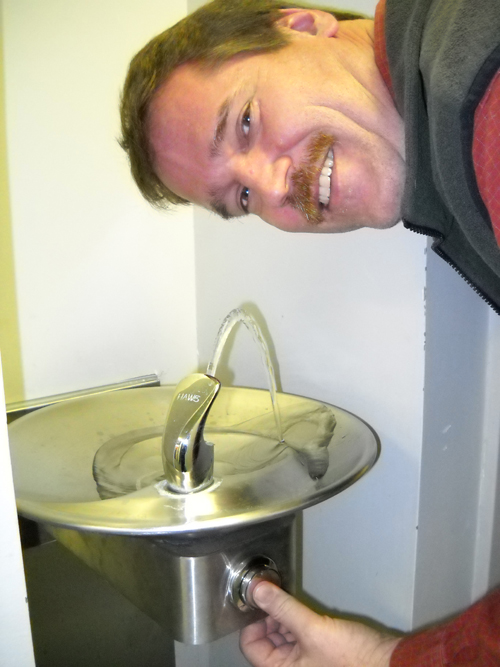
Drugs in your drinking water? Relax. Headlines about potentially harmful pharmaceuticals and related chemicals entering drinking water and affecting human health are often misleading, says Prof. Paul Sibley, School of Environmental Sciences (SES).
Those headlines say less about water safety and more about public and media misunderstanding of science and risk, says the Guelph professor. They also point to another culprit: scientists themselves. “As scientists, we are often very poor communicators. If scientists can’t communicate the technical basis of what they have to say ─ that this issue is or is not a problem ─ then the public is not going to understand.”
Sibley discussed risks, science and drinking water safety during a Café Scientifique event held in Guelph late last month. About 50 people attended his public talk.
He and other Guelph researchers have examined a number of pharmaceuticals and personal care products (PPCPs) found in drinking water supplies. He says only a few of these substances raise warning flags. That includes chemicals that mimic or block hormones and disrupt the body’s normal functions, such as the active ingredient in oral contraceptives.
Studies have shown that some of these endocrine disruptors may affect fish, including reducing populations and altering male and female traits. Hormones have evolved naturally to work in vanishingly small amounts, equivalent to less than a drop in an Olympic-sized swimming pool.
A wastewater treatment plant may contain hundreds of pharmaceuticals and related chemicals found in personal care products such as antimicrobial soap or shampoo. Most of those products are not endocrine disruptors. And most linger in much lower concentrations than toxicity thresholds, says Sibley.
He says many people perceive problems with drinking water and the environment, but lack technical information to know whether chemicals pose a risk to health or safety. More often, he says, the typical response is an all-or-nothing one: “They’re in my drinking water. That’s got to be bad.”
Another common response is to call for regulations, even when they may be neither needed nor effective. “It would be very difficult and likely impractical to regulate so many PPCPs, especially when so few pose little risk. It may be more efficient to target specific problem chemicals within the class.”
Sibley says people also need to consider tradeoffs. For instance, weigh the objections to using chlorine to disinfect drinking water ─ and risks of potential disinfection by-products ─ with the possible health threats of water-borne pathogens.
Along with Prof. Keith Solomon, a toxicologist and professor emeritus in SES, Sibley has studied about 35 PPCPs at Guelph, including endocrine disruptors, antibiotics and sulfa drugs. They’ve investigated effects on microbes, invertebrates, fish and plants in lab and field studies, including wastewater effluent in the Grand River.
On campus, they also run experiments in U of G’s microcosm facility. Located at the Guelph Turfgrass Institute, the one-of-a-kind facility consists of 30 artificial mini-ponds. Their studies have been used to help in testing, risk assessment and setting of regulations for pesticides and other chemicals by Environment Canada and Health Canada.
Currently, Sibley is looking at fluorinated surfactants, chemicals used in stain repellants and coatings for carpets, clothing and furniture. He hopes to learn more about the toxicity of these compounds, some of which are long-lasting and able to migrate long distances.